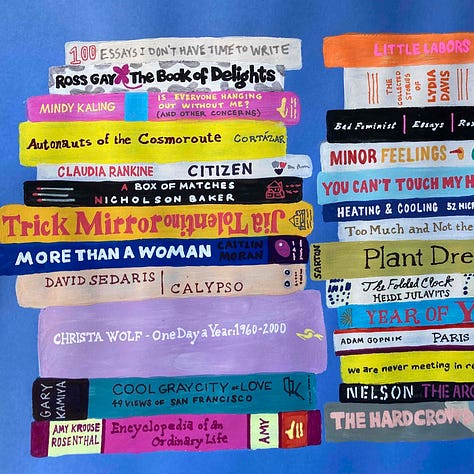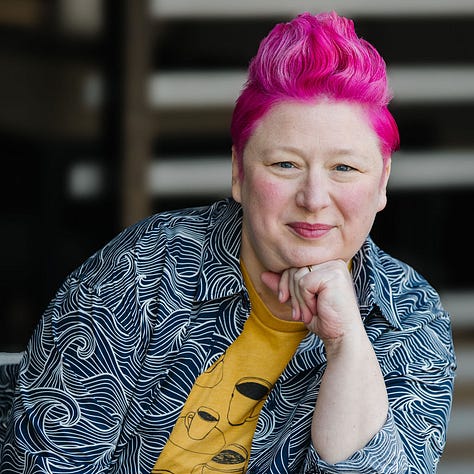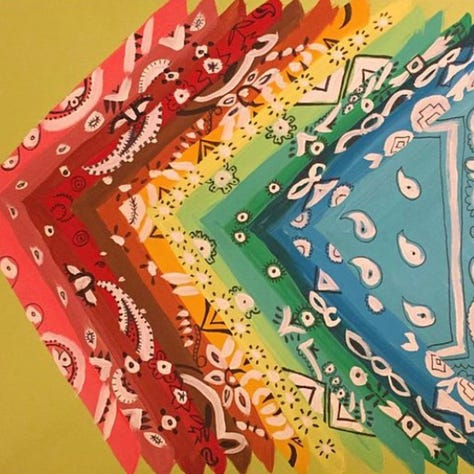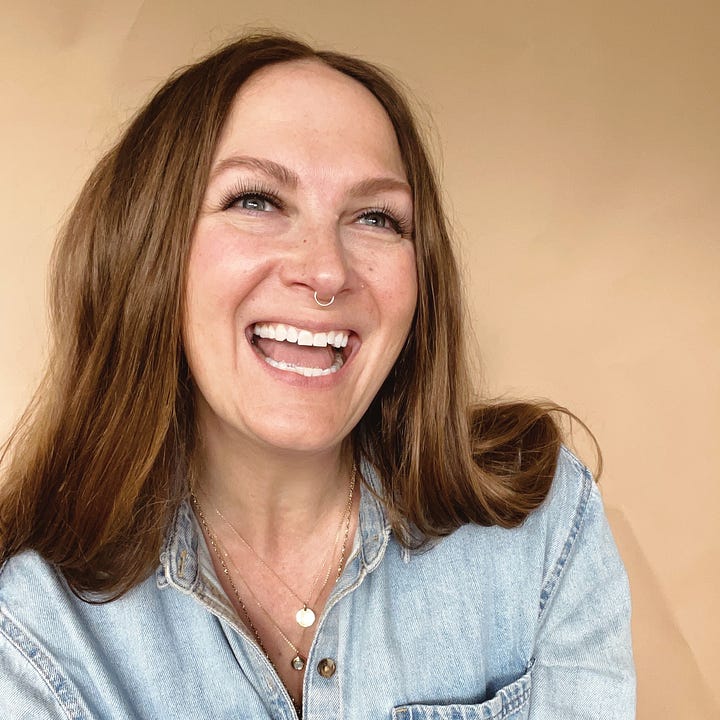These Three Things with Bridget Watson Payne
Artist and Author Bridget Watson Payne shares three life lessons that have shaped her creative life.
I’m so glad you’re here! Today, I’m thrilled to share a special These Three Things guest feature with the brilliant and hilarious
. Her reflections are wise, deeply observant, and full of inspiring wit and wonder. After you read, I’d love to hear from you! Share your own three things in the comments below. I read and appreciate every single one.


Bridget and I first met around 2015 or 2016, when I stopped by her then office at Chronicle Books to deliver a necklace she’d won in a charity auction. Back in the days when I was a jewelry designer. Within minutes, I knew I wanted to be her friend. She’s hilarious, has the best laugh, and is both wildly creative and whip-smart. In short, a total gem.
Over the years, Bridget and I have found each other again and again through creative work. She interviewed me for her book How Time Is on Your Side, and I invited her to join me for a few episodes of my podcast Joy Is Now (you can listen here and here). I’m delighted to have her as a guest this week to share her three things, each one a perfect reflection of her humor, intelligence, and sense of wonder.
Bridget is an editor, writer, and artist based in San Francisco. For over twenty years, she collaborated with hundreds of authors at Chronicle Books, helping to turn their ideas into beautiful books. Today she works as a freelance editor and creative consultant for publishers and individual authors and artists. She’s the author of eight books, including her newest, The Wonder of Colors. She’s also an accomplished speaker and teacher, having appeared at CreativeLive, Alt Summit, Craftcation, and Creative Mornings, among others. Her original artwork has shown at galleries including Park Life in San Francisco and is available at Post.Script. You can also find her writing and creative insights through her Substack newsletter, website, on Cara and Instagram.
These Three Things with Bridget Watson Payne
1. In grad school I wrote my thesis on the 19th Century novelist George Eliot. She’s often forgotten or overlooked today, but she was a genius of empathy. One of her greatest observations was the simple fact that other people are just as real as we are ourselves. And that, if we are going to be wise compassionate adults, we will spend our entire lives working to truly get our heads around that fact. It seems simple but it’s not. We believe in our own reality more than others’ simply because we live inside our own minds. You can say its selfish, but it’s also human nature. We can’t help each feeling like the center of our own universe on a visceral level. But we can fight against that feeling and learn to care for others. She put it this way (get ready, this is some dense Victorian prose, but it’s worth it): “Your pierglass or extensive surface of polished steel made to be rubbed by a housemaid, will be minutely and multitudinously scratched in all directions; but place now against it a lighted candle as a centre of illumination, and lo! the scratches will seem to arrange themselves in a fine series of concentric circles round that little sun. It is demonstrable that the scratches are going everywhere impartially, and it is only your candle which produces the flattering illusion of concentric arrangement, its light falling with an exclusive optical selection. These things are a parable. The scratches are events, the candle is the egoism of any party now absent.” ― George Eliot
2. The power of close-looking and the magic of the boring. During a time in my life when things were hard I started to gradually notice that if I looked around me as I walked to work in the morning -- if I paid attention to the morning light, and the buildings, and the trees -- if I kept an eye out for the small unusual thing that was different than the day before, not because it was so very special, but just because I was seeing it: a particular bird, say, or the sunlight on bricks, or a colorful piece of discarded furniture someone had left out for the trash -- I could get out of the worried spin of my own thoughts and drop into the actual real world around me. I could use my ability to really see the concrete, specific, often boring material world as a way of being present in my life, a way of appreciating this life I have, instead of being caught up in sadness and worry. It doesn’t always work, of course, but when you can focus on the mundane, and really see it, it can do wonders. Oh shit, I eventually realized, I think that might be mindfulness. Andy Warhol said it beautifully: “You have to let what would ordinarily bore you, suddenly thrill you.”
3. Kiwa Hirsuta. In 2005 scientists discovered a previously unknown crustacean living on hydrothermal vents at the bottom of the Pacific Ocean. Strictly speaking it’s a lobster, though it’s more closely related to the crab. It’s got long front legs like waving arms covered in what looks like silky blonde fur, though they’re actually bristles -- gaining it nicknames like the “furry lobster,” the “yeti lobster,” and the “yeti crab.” But its proper name is Kiwa Hirsuta. This creature was so unique that it required the coining of a new family, genus, and species. The genus, Kiwa, is named after the goddess of shellfish in Polynesian mythology; and the species name, Hirsuta, is drawn from the Latin word for “hairy.” A blonde, furry, long-armed lobster living in extreme conditions way down at the bottom of the ocean, discovered in the 21st Century! Repeat: a long-haired blonde lobster! This thing is extraordinary -- absurd, mind-blowing, and extraordinary -- an example of the absolute pure wonder and superabundant mystery of life on earth. But at the same time, these guys have just been wandering around down there, most likely blind, probably using bacteria living in their bristles to detoxify the poisonous minerals that come up out of the undersea vents they make their homes on top of, eating who-knows-what (even the scientists aren’t sure) for thousands and thousands and thousands of years. They’ve just been going about their business, marvelous and unnoticed by human beings, all this time. I love this so much. I think about it at least once a year and have for the past two decades.
So now I ask you:
When have you been reminded through art, conversation, or experience that other people are just as real and complex as you are? How has that realization changed the way you move through the world?
What helps you return to presence when your thoughts start to spiral? Have you ever found comfort or meaning in noticing the small, ordinary details of your surroundings?
What’s something you’ve discovered, large or small, that filled you with awe for the strange and beautiful world we live in?
If none of these prompts speak to you, feel free to share your These Three Things in the comments in any form that feels right. There are no rules here, just curiosity, reflection, presence, and space to begin again.
Feel free to take it to Notes! Tag me using
and I’ll give you a shoutout. Let’s see where this journey takes us when we all share what we’ve learned along the way.Thank you so much for the inspiration this week, Bridget.
And as always, thank all of you for being here.
xxx
Lisa
Unlearned
Next week,
returns for Paid Subscribers to share what she’s unlearned. A reminder that joy, confidence, and freedom often begin when we stop following the rules we never agreed to in the first place.Not yet a paid subscriber? You won’t want to miss this one.
P.S. Paid subscribers also get the The Full Muse Experience. Monthly reflections, powerful prompts, deep dive essays, and a 5 day intensive that will light up your creativity and break down your blocks. Let’s make something extraordinary, together.
You’ll get:
In Practice – Monthly creative tone setting.
These Three Things: Practice Edition – Prompts, exercises, and Unlearned insights from featured creatives.
Dear Creative – 5 days of pep talks, practices, and inspiration each month.
The Creative – Meditative essays to keep your momentum alive.





This is fantastic. How Bridget moves between intellect, observation, and wonder is such a clear reflection of how creative thinking actually works in the real world.
Lately, what’s been reminding me that other people are just as complex as I am is design critique. Collaboration where everyone’s trying to articulate what “works” without having the same language for it. You realize fast that everyone’s carrying their own story, their own lens, and somehow the work becomes the meeting point.
And yes to the magic of the boring. For me it’s typography on street signs.
Yeti lobster?! I feel both completely in awe and weirdly comforted by the idea that something that strange has just been vibing at the bottom of the ocean, minding its own hairy business for thousands of years. It’s the best kind of wonder!!